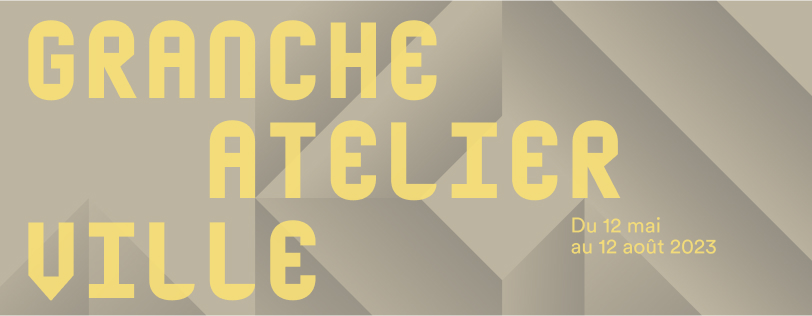
This summer, the Centre d’exposition de l’Université de Montréal (CEUM) is hosting a monographic exhibit of the works of artist and Université de Montréal professor Pierre Granche (1948-1997). Curated by CEUM director Laurent Vernet, Granche / Atelier / Ville is the first major presentation of the work of this important artist and teacher since 2002.
The exhibit draws from the artist’s collection of 2,700 documents (plans, drawings, models), as well as from his personal archive, wich cover over 6 linear metres. The Université de Montréal has maintained and kept this rich body of work, but despite this, the CEUM team found that little research had been done on the artist since his death. A large portion of the research on Pierre Granche was published during his career in cultural magazines such as Espace Sculpture (now Espace : art actuel), Intervention (now Inter), Ciel variable and Vie des arts. More than 25 years later, this research is still relevant and is accessible through the erudit.org platform.
We invite you to discover seven of these articles, which contributed to the creation of the exhibit and shed light on the works on display. During your visit to the exhibit, you might notice QR codes next to some works of art, wich wuill lead you directly to the articles.
Happy reading and enjoy your visit!
Pierre Granche in Érudit’s Collections
(1980). Pierre Granche. Intervention, (9), 22–25.
Learn more about Pierre Granche’s artistic process. In this interview, the sculptor comments on several of his art installations from the 1970s and early 1980s, notably Lieu in-fini (1980), designed and created for the Symposium international de sculpture environnementale of Chicoutimi.
The mock-up for this project, as well as photographs and archive documents, are part of the exhibit presented by the CEUM.
Poissant, Louise. (1991). Pierre Granche : vingt années de sculpture. Vie des arts, 36 (145), 54–59.
This article celebrates twenty years of artistic success! Pierre Granches’s quest to integrate his work into the environment is highlighted by Louise Poissant, who divides his dynamic career into three stages: from the truncated pyramid, to the blending of sculpture and architecture, to the fusion of architecture and the urban landscape.
Fisette, Serge. (1992). Si le temps de la rue… faisait beau : une histoire de ville/Si le temps de la rue… faisait beau : A Story of a City. Espace Sculpture, (20), 6–13.
Have you seen Pierre Granche’s Comme si le temps… de la rue? You would have come across it between Place des arts and the Musée d’art contemporain in Montréal. In this article, Serge Fisette delves into how, through this art installation, the sculptor not only fused his art into the urban environment, but how he also managed to incorporate the city itself into his work.
Archival material from this project is presented as part of the CEUM exhibit.
St-Pierre, Gaston. (1998). Sans poids ni mesure. Vie des arts, 42 (172), 31–34.
“How could such a cerebral artist, working from such uncommon knowledge, be this popular?”
That’s the question that Gaston St-Pierre answers in this retrospective on the career of Pierre Granche, written not long after his death in 1997. Using some of his works as examples, this article highlights Granche’s multifaceted talents, as he managed to cleverly blend his creations into their environment.
Lefebvre, Germain. (1979). Une sculpture qui naît d’un espace partagé. Vie des arts, 24 (96), 26–29.
In this article, Germain Lefebvre covers Pierre Granche’s sculptural work and places it in its artistic context. Melding art and science, the artist’s research led him to push back formal boundaries through explorations of geometry, space and architecture. Interrelations cubiques d’un système sculptural (1976), built at the Complexe Desjardins and removed in 1991, is a striking example of that process, which this article discusses.
Explore this project through the archives presented at the CEUM.
Hanel, Olaf. (1997). Pierre Granche : Genius loci. Espace Sculpture, (41), 22–24.
Let yourself be carried away by this story told by Olaf Hanel, who accompanied Pierre Granche and his partner Gisel Saint-Hilaire to Prague in 1997. Hanel was chosen to write about the artist’s work during a residency for the 10th anniversary of the magazine Espace Sculpture. The author shares his impressions of this encounter and reflects on Prague’s policy of preserving public art and integrating contemporary art into the city.
The photographs from the “Prague” series which resulted from this trip are currently part of the CEUM exhibit.
Laframboise, A. (2005). Dans la ville instable. Ciel variable, (69), 19–21.
Alain Laframboise, then Professor of Art History at the Université de Montréal, also discusses the “Prague” photographic series. By a play on associations, the author highlights the similarities between the convex mirror used by Pierre Granche and Parmigianino’s Self-Portrait in a Convex Mirror (1524), the mirror that Brunelleschi used in his experiments with portraying architecture (Tavoletta, ca. 1415), or even the shield that Athena offered Perseus for his confrontation with the Gorgon.
Visit the Granche / Atelier / Ville exhibit at the CEUM to see photographs from the “Prague” series.